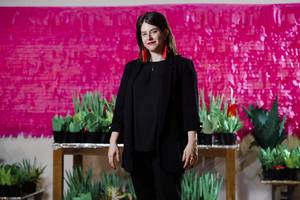The year was 1976. Queer, Chicanx artist Joey Terrill hand-printed a series of T-shirts emblazoned with the words “Maricon,” a Spanish slur for gay men, and “Malflora,” the derogatory equivalent of lesbian, across the chest. On the back was one more: “Rolemodel.”
A black and white self-portrait of Terrill in his subversive tee covers a wall inside UNLV’s Marjorie Barrick Museum of Art, part of the Axis Mundo: Queer Networks in Chicano L.A. exhibition, which opens on Friday. The traveling exhibit was organized as part of Pacific Standard Time: LA/LA, an initiative in Los Angeles—sponsored by the J. Paul Getty Museum—with the goal of investigating Latin American and Latinx art histories through a series of exhibitions in 2017.
Axis Mundo was one of those exhibits, the result of four years of research and development on behalf of ONE National Gay & Lesbian Archives at the USC Libraries and curators C. Ondine Chavoya and David Evans Frantz, all in collaboration with the Museum of Contemporary Art, Los Angeles (MOCA).
Understanding the context of Axis Mundo is imperative to grasping its importance. For one, it’s the first exhibit of its kind to showcase queer Chicanx artists in the same institutional setting that their cis, white counterparts have historically and regularly been celebrated. It also gives credence to the often-overlooked queer Latinx communities of LA from the late ’60s through the early ’90s, documenting life as a cultural and political movement that not only contributed to art, activism and fashion, but provided powerful commentary and reactions to the racism, xenophobia, homophobia, transphobia and violence it endured.
“The research process was super-global as well as hyper-local,” Frantz says. He and Chavoya spent time in Mexico, Spain and England and sat with artists’ surviving partners, family members, band members and friends to learn more about the artists and their histories.
“Developing relationships and trust was fundamental and essential to having people open up their homes, their studios and their memories,” Chavoya says. “Often times, when we were reaching out to artists or surviving partners and family members, they would tell us, ‘You’re the first ones to come and ask about our loved one.’”
Through grassroots and DIY organizing, LA’s queer Chicanx community displayed its resistance and resilience through art, music, performance and, Chavoya emphasizes, pleasure. Photographs on display include portraits of living Chicanx punk legend Alice Bag, photographs of LA punk band Nervous Gender, self-portraits of Judith Baca and paintings by Axis Mundo namesake Edmundo “Mundo” Meza himself.
Some works, like Jef Huereque’s “My Parents in Their Matching Zoot Suits,” (1973), literally sat inside his living room next to his family portraits for decades. Others were lost in moves or placed in storage. In addition to these found artworks, Frantz and Chavoya uncovered a network of artists and worlds (another play on the word Mundo) across the globe who share the same ties to this LA-based Latinx community, whose work continues to influence queer Chicanx movements today.
“For many of the art objects inside the exhibition, this is the first time that the works are being shown in a museum context and the first time they’re being shown since they were produced,” Frantz says.
Frantz points out that many of the artists in the exhibition were impacted by the AIDS crisis, which contributed to the disappearance of their histories over time. Meza, for example, was revered among his peers and community for his paintings and performance art, though he never exhibited at museums in his lifetime. Meza’s work was dispersed among his family and friends after he died of AIDS complications in 1985, and it’s only since Axis Mundo that his work has been brought to a larger audience.
“That lack of recognition fundamentally has to do with xenophobia, institutional racism and the ways in which the field of art history has been really closed off, and the museum institutions have been exclusionary,” Chavoya continues. “What we see in this exhibition are artists who recognized early on in their careers that the museum was a closed field to them—so what they did was create their own means of access, their own alternative art institutions through which they could both exhibit, produce and circulate their work.”
Axis Mundo has shown previously at the MOCA in LA, Hunter College Art Galleries in New York and the Vicki Myhren Gallery at the University of Denver. It’s the Barrick Museum’s first exhibition with text in both Spanish and English. A guided tour with Frantz and Chavoya will take place on Friday, January 11 at 7 p.m. The exhibit runs through March 16.
Axis Mundo: Queer Networks in Chicano L.A. January 11-March 16; Monday-Friday, 9 a.m.–5 p.m.; Saturday, noon–5 p.m.; $2-$5 suggested contribution. Opening reception January 11, 5-9 p.m. UNLV’s Marjorie Barrick Museum of Art, 702-895-3381.







